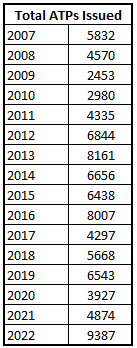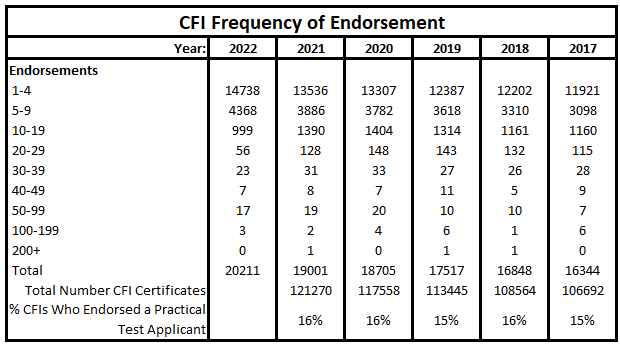The following is a screen record of the slides and audio from the 2023 Michigan Aviation Safety Forum (MASF) MI FAASTeam Presentation at Eastern Michigan University on February 11, 2023 – Non-Towered Airports Operations, Conflicts, and Remedies with Jason Blair and Andrew Focks. The presenters are not visible, but the slides from the seminar are viewed and the audio is able to be heard.
The volume of ATP certificates issued in the United States is something that directly relates to our ability to provide pilots for commercial airline operations. As a base certificate requirement, only pilots who meet this certificate level can be employed at airlines, and many cargo carriers, operations. As such, knowing how many of these we issue each year is something that directly helps us as an industry understand our ability to staff these job functions.
This past year, 2022, we generated more ATP certificate issuance in the United States than any recent year; doubling what we have done in either of the past two years and significantly more than what we have issued in any one year in well over a decade.
But is this enough? Well, that’s a different question and one we can also contextualize.
First, let’s look at the numbers.
Increased Total ATP Certificates Issued in 2022

This past year we saw what appears to be a total of 9387 ATP certificates issued. This outpaces what we have done in recent years, and, in fact, I have been tracking these numbers since 1990 and at no point in that time have we issued more than 9000 ATP certificates in any year. This is kind of a record year.
It is worth noting that in the past couple of years, the lower numbers of issuances were surely affected by the effects of COVID. We see a similar drop in issuance numbers per year in 2009 and 2010 as regulatory changes took effect regarding what requirements needed to be met to qualify for an ATP certificate. Taking these two anomalies out of the averages, we typically issue an average of around 6000 ATP certificates per year, so 2022 is a high point and shows a significant increase in our issuance trend.
Highly active hiring and demand for ATP-qualified pilots is a major factor that has driven the training for and certification of pilots in the past year. Since a large portion of the ATP certificate training and certification is now done at airlines in their initial training processes, the entities needing these pilots are directly affecting the training volume to meet their own employee needs.
It’s that time of the year when a data point is shared relating to how many instructors sign off applicants for certificates and ratings in the FAA system. Looking back at 2022, the flight training industry has felt great pressure to deliver more pilots faster to a hungry airline hiring beast. As the industry attempts to feed CFIs who have met the requisite experience (total time) requirements into the hiring process for airline service, most flight training providers have seen heavy turnover in their CFI staff. In most major flight training operations, CFIs are turning over in their position between 10-16 months of time in the job (as a CFI).
Anecdotally, we have heard from students in training that they have had less stability in their training when it comes to having just one or even two instructors throughout their training. The heavy turnover of CFIs has resulted in it becoming normalized for a student to have 3, 4, 5, or even more CFIs that work with them during any particular certification training. And this isn’t through ALL of their training, it is per particular certificate or rating. We get it, CFIs want to move on to other jobs many times.
But there are effects in the system to this condition. It means that fewer CFIs are actively engaged with training students over longer periods of time. It generally tracks that as CFIs provide more training, they get better at it. They figure out how to do the job better. They learn to be able to tell when a student is really ready for a practical test, and when they are not if they do the job longer. Experience as a teacher typically makes teachers better. Having CFIs who never gain that experience in the majority of our training sector cannot be a good thing.
We are seeing in our numbers that there are more CFIs giving “signoffs” for a certificate and/or rating in a given year over the past few years than did so historically. While we do know that training numbers overall are up, that doesn’t necessarily mean that more CFIs are training more people. It may mean that more CFIs are signing off fewer numbers of applicants personally. It’s a mix of things we are seeing here. More CFIs doing signoffs, and more people completing training, but that isn’t necessarily a one-to-one comparison.
If a CFI signed off 10 students, that would mean that 10 people got signed off. But it is also possible that 2 CFIs could sign off 6 people each and end up with 12 people signed off. Two CFIs signing people off doesn’t necessarily mean that we got 20 people signed off.
Follow? Hopefully, I haven’t confused you too much yet.
The point is here we are tracking a number, being the endorsement activity here, that gives us a data point, but it should be considered in conjunction with other data. Specifically, some data that we will see in the next couple of months, the total certification events that took place in 2022 also. If you are reading this, check back here in the upcoming months and I will highlight what we see in that data when it comes out.
Ok, ok, so I said I would share some numbers. So here they are: Continue reading
Continue reading
Should pilots be trained as generalists, with a broad set of base skills, and then made into specialists for specific conditions and operational environments? Or should we be training pilots to specialize in a specific role and not worry about building generalist skills into them that may not be needed in the jobs they are going to end up doing?
It’s an interesting philosophical question when it comes to the strategy of training pilots.
The U.S. aviation training system is one that has been based on mentorship and one-on-one relationships between instructors with their students for many decades. We trust that a more senior CFI will work with a new or lessor experienced student to pass along knowledge, skills, and risk management mindsets that will develop them into capable pilots. It’s a stepping stone process that builds basic pilotage and then enhances that knowledge base by adding skills and knowledge as they proceed from being a pilot capable of flying themselves to being one that might be tasked, and trusted, with flying hundreds of passengers in the back of their aircraft for hire.
We still train pilots in “little airplanes” to fly basic VFR around our national airspace system and to fly in instrument conditions under the instrument procedures rules. This is all done in the general aviation flight realm. But once we have done this, and after these pilots have gained some experience, they are unlikely to fly in this operational environment again in most cases for modern professional pilots. They leave this realm and transition to regional and major airlines and cargo carriers and fly in the commercial operations realm. While general aviation and commercial operations share the same airspace sometimes, how they get flights done is very different. In most larger commercial operations, the pilots have a great operational infrastructure that ranges from ramp help to dispatchers that feed them information, to cabin crew, and an overall operational specifications process that enhances and ensures safety. A general aviation pilot has none of this. And, in fact, training someone as a general aviation pilot from the outset may, in the opinion of some, actually detract from the development of working within this larger framework that is a commercial operation. A general aviation pilot is many times more of a lone wolf; responsible for all the decisions and planning for a flight themselves.
There is an argument to be made that building this individualistic skill set is something that a pilot needs to have so they can have that skill if ever needed later in their career. But, is that argument still accurate? Continue reading

